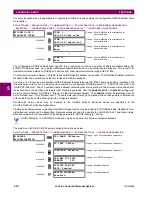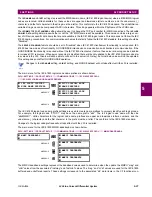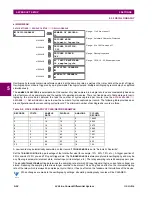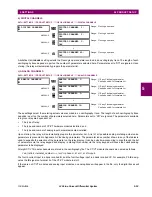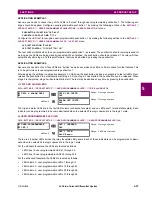
GE Multilin
L30 Line Current Differential System
5-47
5 SETTINGS
5.2 PRODUCT SETUP
5
See the
Settings > Product Setup > Real Time Clock
section of this manual for a description of when time values
received via PTP are used to update the relay’s real time clock.
The following settings are available for configuring the relay for PTP.
PORT 1 ... 3 FUNCTION
•
While this port setting is selected to disabled, PTP is disabled on this port. The relay does not generate or listen to
PTP messages on this port.
PORT 1 ... 3 PATH DELAY ADDER
•
The time delivered by PTP is advanced by the time value in this setting prior to the time being used to synchronize the
relay’s real time clock. This is to compensate to the extent practical for time delivery delays not compensated for in the
network. In a fully compliant PP network, the peer delay and the processing delay mechanisms compensate for all the
delays between the grandmaster and the relay. In such networks, this setting should be zero.
•
In networks containing one or more switches and/or clocks that do not implement both of these mechanisms, not all
delays are compensated, so the time of message arrival at the relay will be later than the time indicated in the mes-
sage. This setting can be used to approximately compensate for this delay. However, as the relay is not aware of net-
work switching that dynamically changes the amount of uncompensated delay, there is no setting that will always
completely correct for uncompensated delay. A setting can be chosen that will reduce worst-case error to half of the
range between minimum and maximum uncompensated delay, if these values are known.
PORT 1 ... 3 PATH DELAY ASYMMETRY
•
This setting corresponds to “delayAsymmetry” in PTP, which is used by the peer delay mechanism to compensate for
any difference in the propagation delay between the two directions of a link. Except in unusual cases, the two fibers are
of essentially identical length and composition, so this setting should be set to zero.
•
In unusual cases where the length of the link is different in different directions, this setting should be set to the number
of nanoseconds the Ethernet propagation delay to the relay is longer than the mean of path propagation delays to and
from the relay. For instance, if it is known say from the physical length of the fibers and the propagation speed in the
fibers that the delay from the relay to the Ethernet switch it is connected to is 9 000 ns and the that the delay from the
switch to the relay is 11 000 ns, then the mean delay is 10 000 ns, and the path delay asymmetry is 11000 - 10000 =
+1000 ns.
STRICT POWER PROFILE
•
Power profile (IEEE Std C37.238 2011) requires that the relay only select as a grandmaster power profile compliant
clocks, that the delivered time have worst-case error of ±1 µs, and that the peer delay mechanism be implemented.
With the strict power profile setting enabled, the relay will only select as master clocks displaying the IEEE_C37_238
identification codes. It will use a port only when the peer delay mechanism is operational. With the strict power profile
setting disabled, the relay will use clocks without the power profile identification when no power profile clocks are pres-
ent, and will use ports even if the peer delay mechanism is non-operational.
•
This setting applies to all of the relay’s PTP capable ports.
PTP DOMAIN NUMBER
•
This setting should be set to the domain number of the grandmaster-capable clock(s) to be synchronized to. A net-
work may support multiple time distribution domains, each distinguished with a unique domain number. More com-
monly, there is a single domain using the default domain number zero.
•
This setting applies to all of the relay’s PTP capable ports.
PTP VLAN PRIORITY
•
This setting selects the value of the priority field in the 802.1Q VLAN tag in request messages issued by the relay’s
peer delay mechanism. In compliance with PP the default VLAN priority is 4, but it is recommended that in accordance
with PTP it be set to 7.
•
Depending on the characteristics of the device to which the relay is directly linked, VLAN Priority may have no effect.
•
This setting applies to all of the relay’s PTP capable ports.
Summary of Contents for L30
Page 10: ...x L30 Line Current Differential System GE Multilin TABLE OF CONTENTS ...
Page 30: ...1 20 L30 Line Current Differential System GE Multilin 1 5 USING THE RELAY 1 GETTING STARTED 1 ...
Page 370: ...5 244 L30 Line Current Differential System GE Multilin 5 10 TESTING 5 SETTINGS 5 ...
Page 464: ...A 10 L30 Line Current Differential System GE Multilin A 1 PARAMETER LISTS APPENDIX A A ...
Page 600: ...C 30 L30 Line Current Differential System GE Multilin C 7 LOGICAL NODES APPENDIX C C ...
Page 610: ...D 10 L30 Line Current Differential System GE Multilin D 1 IEC 60870 5 104 APPENDIX D D ...
Page 622: ...E 12 L30 Line Current Differential System GE Multilin E 2 DNP POINT LISTS APPENDIX E E ...
Page 634: ...F 12 L30 Line Current Differential System GE Multilin F 3 WARRANTY APPENDIX F F ...
Page 644: ...x L30 Line Current Differential System GE Multilin INDEX ...




